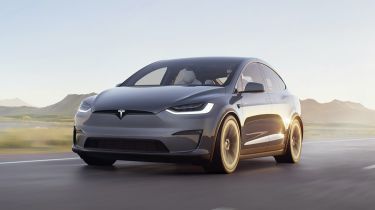Tesla Model X review: performance, motor & drive
The Tesla Model X sets the benchmark for performance in an electric SUV, but rivals are more fun to drive
| Model | 0-60mph | Top speed | Driven wheels | Power |
|---|---|---|---|---|
| Model X | 3.8s | 155mph | Four | 671bhp |
| Model X Plaid | 2.5s | 163mph | Four | 1,019bhp |
The Tesla Model X weighs around 2,300kg, which makes the devastating performance of the Plaid model all the more astonishing when you experience it. It's genuinely shocking when you first get fired up the road, mostly thanks to the silent, unflappable way the car takes off. Handling is a bit flat-footed due to the sheer bulk of the thing, and the steering (note: the Model X is now left-hand drive only) is devoid of feedback. But the Model X is precise and neutral enough most of the time to offer at least some satisfaction on a swift drive down your favourite country road.
Tesla Model X electric motor, 0-62mph and acceleration
Let’s start at the top, with the Plaid. It's flat-out bonkers; a YouTube sensation of a car that'll beat the craziest supercars off the line, and will likely see 60mph first, too, given its 2.5-second sprint time. It sets a benchmark and then some for electric SUV performance and has a top speed of 163mph.
The standard Model X is also pretty gobsmacking: its 0-60mph figure is 3.8 seconds, while top speed is 155mph. Yet, despite the savagery of the Tesla’s performance, it's also a very easy car to drive at normal speeds – if you ignore the fact that since May 2023 every Model X built is left-hand drive, that is – thanks to the progressive nature of the electric motor. You can make effortless progress through the ebb and flow of town traffic without giving it much thought at all.
Handling
The Model X can’t really be described as agile, but it doesn’t suffer the lumbering, ponderous handling of some large SUVs. This is thanks to the batteries sitting low in the body, which lowers the Model X’s centre of gravity and thus reduces body lean.
Both Model X variants use Tesla’s dual-motor, four-wheel-drive system, so there’s masses of traction to ensure they feel planted even on poor surfaces or in bad weather. It all feels neutral and grippy enough that you can swing the big Tesla through direction changes with cheerful gusto.
There’s even ‘smart’ air suspension with adaptive dampers, which can vary the car’s ride height depending on speed and the kind of surface you’re travelling on, also taking into account data from the sat nav. It’s a shame then that the setup is rather firm overall and doesn’t offer the same ‘floating’ sensation over bumps as rivals also sporting air suspension do.
The Model X’s steering also feels rather unconvincing and artificial. It’s a bit computer-game-like – accurate and controllable, but you rely on your eyes and ears to gauge when the Tesla is close to its limits. Regardless, if you’re looking for an engaging drive from your electric SUV, a BMW iX or Jaguar I-Pace will ultimately be more satisfying on a twisty road – even if they aren’t as fast in a straight line as the Tesla.

